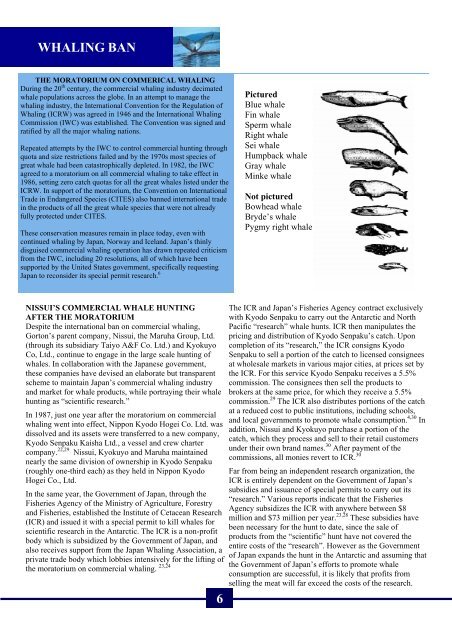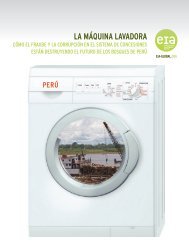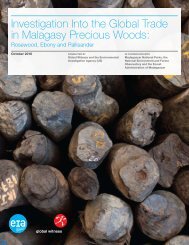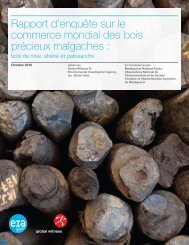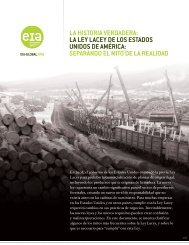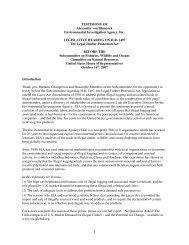The Gorton's Family Whale Killing Business - Environmental ...
The Gorton's Family Whale Killing Business - Environmental ...
The Gorton's Family Whale Killing Business - Environmental ...
Create successful ePaper yourself
Turn your PDF publications into a flip-book with our unique Google optimized e-Paper software.
WHALING BANTHE MORATORIUM ON COMMERICAL WHALINGDuring the 20 th century, the commercial whaling industry decimatedwhale populations across the globe. In an attempt to manage thewhaling industry, the International Convention for the Regulation ofWhaling (ICRW) was agreed in 1946 and the International WhalingCommission (IWC) was established. <strong>The</strong> Convention was signed andratified by all the major whaling nations.Repeated attempts by the IWC to control commercial hunting throughquota and size restrictions failed and by the 1970s most species ofgreat whale had been catastrophically depleted. In 1982, the IWCagreed to a moratorium on all commercial whaling to take effect in1986, setting zero catch quotas for all the great whales listed under theICRW. In support of the moratorium, the Convention on InternationalTrade in Endangered Species (CITES) also banned international tradein the products of all the great whale species that were not alreadyfully protected under CITES.<strong>The</strong>se conservation measures remain in place today, even withcontinued whaling by Japan, Norway and Iceland. Japan’s thinlydisguised commercial whaling operation has drawn repeated criticismfrom the IWC, including 20 resolutions, all of which have beensupported by the United States government, specifically requestingJapan to reconsider its special permit research. 6PicturedBlue whaleFin whaleSperm whaleRight whaleSei whaleHumpback whaleGray whaleMinke whaleNot picturedBowhead whaleBryde’s whalePygmy right whaleNISSUI’S COMMERCIAL WHALE HUNTINGAFTER THE MORATORIUMDespite the international ban on commercial whaling,Gorton’s parent company, Nissui, the Maruha Group, Ltd.(through its subsidiary Taiyo A&F Co. Ltd.) and KyokuyoCo, Ltd., continue to engage in the large scale hunting ofwhales. In collaboration with the Japanese government,these companies have devised an elaborate but transparentscheme to maintain Japan’s commercial whaling industryand market for whale products, while portraying their whalehunting as “scientific research.”In 1987, just one year after the moratorium on commercialwhaling went into effect, Nippon Kyodo Hogei Co. Ltd. wasdissolved and its assets were transferred to a new company,Kyodo Senpaku Kaisha Ltd., a vessel and crew chartercompany. 22,29 Nissui, Kyokuyo and Maruha maintainednearly the same division of ownership in Kyodo Senpaku(roughly one-third each) as they held in Nippon KyodoHogei Co., Ltd.In the same year, the Government of Japan, through theFisheries Agency of the Ministry of Agriculture, Forestryand Fisheries, established the Institute of Cetacean Research(ICR) and issued it with a special permit to kill whales forscientific research in the Antarctic. <strong>The</strong> ICR is a non-profitbody which is subsidized by the Government of Japan, andalso receives support from the Japan Whaling Association, aprivate trade body which lobbies intensively for the lifting ofthe moratorium on commercial whaling. 23,246<strong>The</strong> ICR and Japan’s Fisheries Agency contract exclusivelywith Kyodo Senpaku to carry out the Antarctic and NorthPacific “research” whale hunts. ICR then manipulates thepricing and distribution of Kyodo Senpaku’s catch. Uponcompletion of its “research,” the ICR consigns KyodoSenpaku to sell a portion of the catch to licensed consigneesat wholesale markets in various major cities, at prices set bythe ICR. For this service Kyodo Senpaku receives a 5.5%commission. <strong>The</strong> consignees then sell the products tobrokers at the same price, for which they receive a 5.5%commission. 29 <strong>The</strong> ICR also distributes portions of the catchat a reduced cost to public institutions, including schools,and local governments to promote whale consumption. 4,30 Inaddition, Nissui and Kyokuyo purchase a portion of thecatch, which they process and sell to their retail customersunder their own brand names. 30 After payment of thecommissions, all monies revert to ICR. 30Far from being an independent research organization, theICR is entirely dependent on the Government of Japan’ssubsidies and issuance of special permits to carry out its“research.” Various reports indicate that the FisheriesAgency subsidizes the ICR with anywhere between $8million and $73 million per year. 23,28 <strong>The</strong>se subsidies havebeen necessary for the hunt to date, since the sale ofproducts from the “scientific” hunt have not covered theentire costs of the “research”. However as the Governmentof Japan expands the hunt in the Antarctic and assuming thatthe Government of Japan’s efforts to promote whaleconsumption are successful, it is likely that profits fromselling the meat will far exceed the costs of the research.


